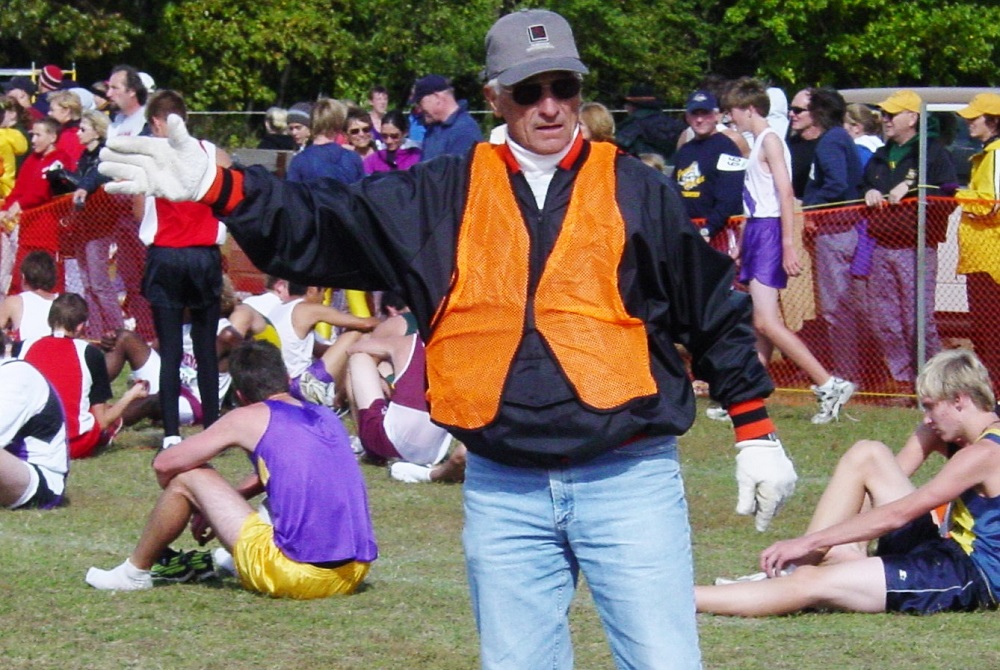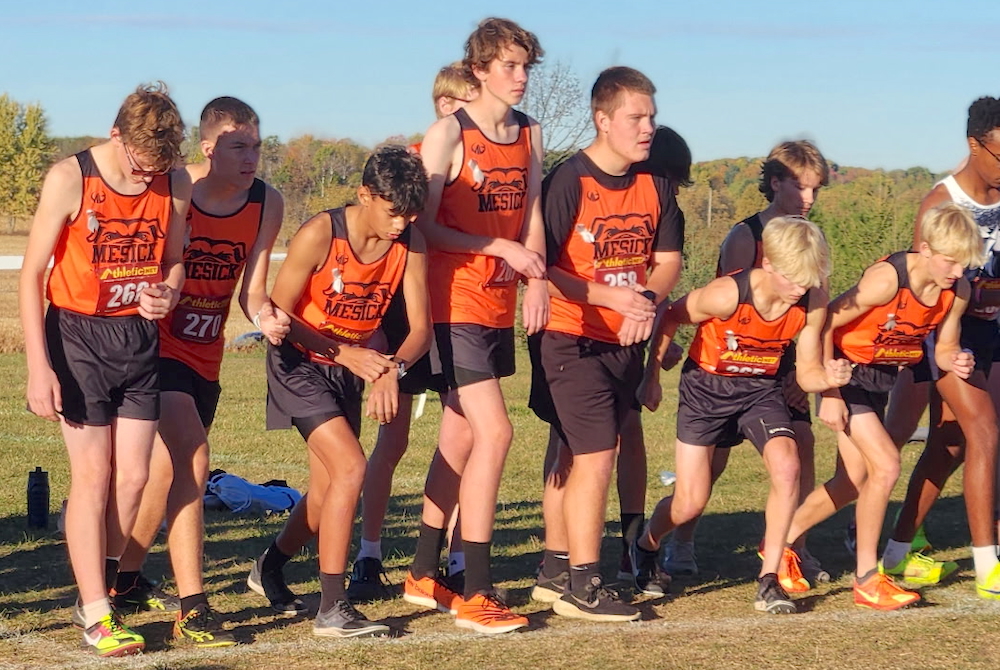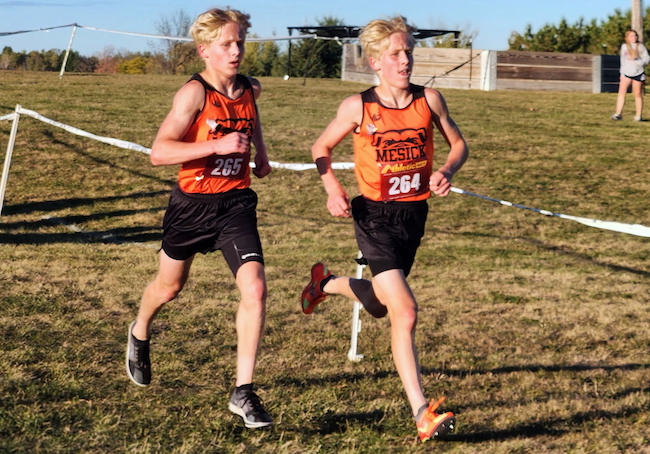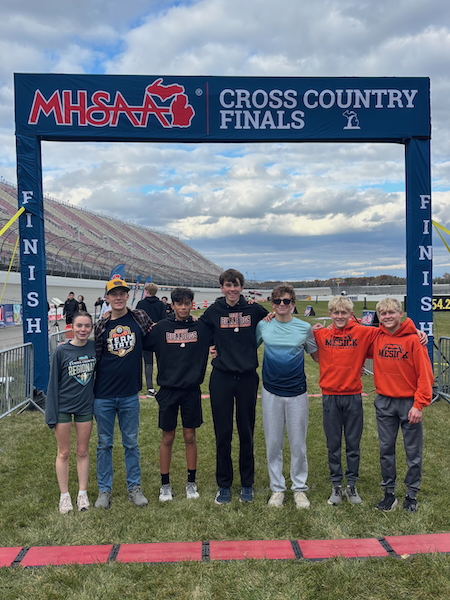
Jackson's Janke Recalled as 'Larger than Life,' Always Willing to Help
By
Doug Donnelly
Special for MHSAA.com
January 26, 2022
JACKSON – A few days before Christmas, Jackson boys track & field head coach Corey Pryor was called to meet with Charles Janke, the longtime former Jackson coach and teacher.
 Janke was very ill and in the final days of his life. Janke, it turns out, wasn’t leaving anything to chance.
Janke was very ill and in the final days of his life. Janke, it turns out, wasn’t leaving anything to chance.
“He asked me if the stadium was ready for our big track meet, the one named after him,” Pryor said. “Believe it or not, that’s what he asked. He was always so organized and meticulous. He wanted to make sure everything was always on schedule.
“I am grateful for getting the chance to spend a few more moments with him.”
Janke, 85, died Dec. 30 at Henry Ford Allegiance Hospice Home in Jackson.
Janke was a track and cross country coach for Jackson who was recognized statewide for his commitment to high school athletics, student athletes and the two sports he loved the most. Although he retired from coaching nearly two decades ago, he remained very involved in high school sports. He was a leader in both sports across the state, a giant in the high school running community.
A Detroit native who went to Central Michigan University to play football, Janke had short stints at Southfield and Milford schools before moving to Jackson where he taught history and physical education. Although he got his start as a football coach, at Jackson he took over the track and cross country programs in 1966. He pulled double duty for years before stepping down as track coach in 1990, but he continued with cross country through 2003 while helping coach the distance runners in track for several more years.
If it involved track & field or cross country in Michigan, Janke was probably involved. He was an early pioneer in the Michigan Interscholastic Track Coaches Association, the first statewide sports-specific association for coaches in the state. He founded several events, including the first countywide cross country meet in Jackson. He hosted, organized and gave presentations at coaching clinics for years and in the early 1970s helped organize indoor track & field meets through MITCA by contacting colleges across the state to see if they were interested in hosting events. He also was the first to publish a MITCA newsletter.
In cross country, he was among those who played a role in bringing all four classes together for a Lower Peninsula championship meet at Michigan International Speedway in Brooklyn. He helped with the event long after coaching. He also served as head field events judge at Big Ten Indoor Championships and became a high school official after retiring as head coach.
His passion for the sport was evident.
“He had a genuine love for the sport,” Pryor said. “He always had his way of doing things. He was a special kind of guy.”
When Pryor was a high school sprinter at Jackson, Janke was an assistant coach who mainly worked with long distance runners.
“He coached hard,” Pryor said, adding that he never fully appreciated Coach Janke until later in life and especially after he became track coach. Pryor found pages and pages of handwritten notes with dates, times and athletes’ names.
“He even wrote down the weather,” Pryor said.
He and Janke had a lot of discussions, often over breakfast, about track events.
“He would be at almost all of the meets,” Pryor said. “He learned every kid by name. He told them he wanted to see them at the state meet. I welcomed him with open arms. When I began to see just what he meant to our state, I realized this guy was a diamond.
“I was blessed to see him behind the curtain. I saw he was the type of guy who really cared about people and wanted to see them succeed. He was more than a coach.”
Vandercook Lake cross country coach Dan Roggenbaum is one of several from the Jackson area who would seek out Janke for advice and mentorship. He said Janke approached officiating with the same rigor and commitment he did coaching.
“Charlie was always willing to help me out with any questions I ever had,” he said. “He was larger than life to me and most other coaches in our county. He was always willing to help and give advice to any of us who were a lot newer to the cross country and track & field scene.”
Two things Janke was most proud of was Withington Stadium in Jackson and the cross country course at Ella Sharp Park named after him.
“I always admired his love and passion for cross country, track & field,” said Ben Pack, now a coach and administrator at Manchester, but once a shot and discus thrower for Janke. “On days of track meets he would have the track set up before the school day started, with the blocks at the starting line, the hurdles stacked along the track to be placed for the first hurdle race, and the throws event areas lined. Every detail for the practices and meets were paid attention to.
“He didn’t do this because he had to do it; he did it because he loved doing it. He always wanted everything to be first class.”
Janke was admittedly a tough coach.
In winning the Al Cotton Award for his dedication to Jackson athletics, the Jackson Citizen-Patriot wrote this about Janke in 2003: “One does not need to talk to many of Janke's athletes or listen very long to get a clear picture of the type of coach he was. He was intense. He was in charge. He demanded respect and he expected the best, and he received a huge measure of both from those who followed his regimen.”
Janke was inducted into both the Michigan High School Coaches Association Hall of Fame and the MITCA Hall of Fame.
Pack said, “During high school we had a sign that read, ‘The mind controls the body.’ In PE strength class we often did exercises that helped us understand how much more we could push ourselves if we fought off the pain of the exercise. Without question, this built mental toughness. He taught kids how to set goals, and the step-by-step process to get to the goal.”
All told, Janke spent more than 60 years involved in track and cross country. His impact will roll on in both sports. A number of former athletes have gone on to become teachers and coaches themselves, like Pack, who not only was an athlete for Janke but coached alongside him. Pack served as Jackson’s varsity football coach from 1987-2002 and again in 2012.
“As peers we often would guide kids to each other’s sports,” Pack said. “Kids that I felt would be better at running cross country, I sent to him. Kids that he felt would be good football players he sent to me. Working together was an honor.”
Jim Martin ran for Janke at Jackson in the 1970s. He’s now in his 36th year coaching track and cross country, the last 26 at Sault Ste. Marie High School. He said he’s a coach today because of the impact Janke had on him.
“At a time in my life that I needed structure and guidance, he was the rock,” Martin said. “He was always there. There's no way I'm in this (coaching) 35 years without him. He was my role model. He cannot be replaced.”
Last fall, Martin took his Sault Ste. Marie team to Jackson for the Charles Janke Invitational. His Blue Devils team won. Going into the meet, he didn’t think that was possible.
“For the life of me I couldn’t figure out how we won that,” Martin said. “We were good, but not Jackson good. … That was the last time Coach Janke saw my team. Now I know why.”
A Celebration of Life service will be held at 2 p.m. on June 12, 2022, at, appropriately, Withington Stadium.
 Doug Donnelly has served as a sports and news reporter and city editor over 25 years, writing for the Daily Chief-Union in Upper Sandusky, Ohio from 1992-1995, the Monroe Evening News from 1995-2012 and the Adrian Daily Telegram since 2013. He's also written a book on high school basketball in Monroe County and compiles record books for various schools in southeast Michigan. E-mail him at [email protected] with story ideas for Jackson, Washtenaw, Hillsdale, Lenawee and Monroe counties.
Doug Donnelly has served as a sports and news reporter and city editor over 25 years, writing for the Daily Chief-Union in Upper Sandusky, Ohio from 1992-1995, the Monroe Evening News from 1995-2012 and the Adrian Daily Telegram since 2013. He's also written a book on high school basketball in Monroe County and compiles record books for various schools in southeast Michigan. E-mail him at [email protected] with story ideas for Jackson, Washtenaw, Hillsdale, Lenawee and Monroe counties.
PHOTO: Charles Janke coaches his Jackson team during a cross country meet in 2003. (Photo by John Johnson.)

After Season of Historic Finishes, Mesick Boys Looking Forward to Another Run
By
Tom Spencer
Special for MHSAA.com
November 22, 2025
Mesick just finished the best boys cross country season in school history.
 And the Bulldogs have even higher expectations for next year.
And the Bulldogs have even higher expectations for next year.
Mesick won a conference championship for the first time, and qualified for the MHSAA Lower Peninsula Division 4 Final for the first time in 38 years.
And the Bulldogs did it all without a senior in the lineup – meaning the entire lineup could be back for more in 2026.
“We’re coming back ready to stay fresh and just honestly do a lot more than we did this year,” said Kyle Redman, who ran a 15:40 to break his own school record and capture first place at his team’s Regional meet. “We want to keep building off that and dig deeper to go further.”
Redman was often the number one runner for Mesick, as was his twin brother Tyler, who finished just seven seconds behind him at the Regional.
Unfortunately, Tyler Redmond aggravated an ongoing hamstring injury and was unable to run in the Final.
“Every goal on our checklist, we hit,” said fourth-year Mesick coach Josh Kaskinen. “We won the conference. We qualified for states, and then right after that Regional race Ty found that he wasn't going to be able to go for states.”
 Mesick had entered just six runners in the Final, and called on Harper Musta to step up just as he did during the conference championship race.
Mesick had entered just six runners in the Final, and called on Harper Musta to step up just as he did during the conference championship race.
Musta, who was battling injuries too as he entered the Final, was the team’s number six runner all season. He ran as the fifth at Michigan International Speedway, ensuring Mesick could place as a team.
“I want to pat Harper on the back as I was a little nervous that we weren't going to score points at state even though we were ranked 11th coming in,” Kaskinen said. “Harper stepped up so that we could actually score and gave us all the experience that we need for next year.”
Despite missing a definite all-state candidate, Mesick still finished 21st at MIS, with Kyle Redman 11th.
The Bulldogs were not surprised Musta came through. He had done it earlier in the season, garnering a lot of credit for the school’s West Michigan D League title.
The Bulldogs narrowly came out on top of the conference championship race with 45 points. Mason County Eastern finished runner-up with 46, and Grand Traverse Academy wound up in third place with 47 points.
“Winning the conference was a big accomplishment,” Tyler Redman said. “For three or four years we were trying to just get people to run cross country, and everybody fought to actually get good at it.”
Kyle Redman led the way in the conference with a first-place finish. Tyler Redman was second. But it was first-year runner and sophomore Musta who found a way to figure in the scoring for the Bulldogs. He didn’t finish in the school’s top five but he did finish ahead of other schools’ top five runners.
“Harper is our assistant coach's older son, and he never ran before,” Kaskinen noted. “I told him leading into that championship meet that his job was to focus on Mason County Eastern's number five guy. I knew it was going to be a close race. And he was able to do it.”
Musta vividly recalls the race, passing Eastern’s fifth runner midway. He admits he wasn’t sure he was up to the challenge. The race gave him his first appreciation of the mental aspects of running.
 “It was a pretty interesting experience,” Musta said. “I actually had a goal in mind, and I had to keep on speeding up and pushing myself. And it was a lot more thinking than I'm usually used to.”
“It was a pretty interesting experience,” Musta said. “I actually had a goal in mind, and I had to keep on speeding up and pushing myself. And it was a lot more thinking than I'm usually used to.”
Musta expects to use that experience to help Mesick to even more success in the years ahead, as does freshman and number three runner Kyle Doty and the Bulldogs’ other regular scorers Gunnar Hallett and Alex Kastl.
With everyone returning, Kaskinen is already looking forward to next season.
“I do think it's going to be a little more competitive for that final scoring spot next year,” he said. “It's kind of cliche, but they were like a brotherhood. They really just came together, and they were closer than I've ever seen a group of kids before.”
Having identical twins lead the team and winning races has been pretty special for Mesick runners.
“It's definitely cool and interesting because we’ve been good friends for a while,” Hallett said. “They're kind of pushing me to do more. Sometimes we just get together and run. And then instantly it's a bit bigger group, and it's easier to do longer runs.”
The twins first started running in an elementary school club led by Rhonda Workman. They played football in middle school.
And while their teammates can tell the difference between the twins, opponents rarely can. All they often know is the guy finishing first was named Redman.
“We get to work off each other, and we have training partners throughout the whole season,” Kyle Redman said. “And it is fun when we’re warming up for the race and they'll be like, ‘Are you Kyle or Ty?’ And then you can just mess with them and they'll never actually know the truth.”
 Tom Spencer is a longtime MHSAA-registered basketball and soccer official, and former softball and baseball official, and he also has coached in the northern Lower Peninsula area. He previously has written for the Saginaw News, Bay County Sports Page and Midland Daily News. He can be reached at [email protected] with story ideas for Manistee, Wexford, Missaukee, Roscommon, Ogemaw, Iosco, Alcona, Oscoda, Crawford, Kalkaska, Grand Traverse, Benzie, Leelanau, Antrim, Otsego, Montmorency, Alpena, Presque Isle, Cheboygan, Charlevoix and Emmet counties.
Tom Spencer is a longtime MHSAA-registered basketball and soccer official, and former softball and baseball official, and he also has coached in the northern Lower Peninsula area. He previously has written for the Saginaw News, Bay County Sports Page and Midland Daily News. He can be reached at [email protected] with story ideas for Manistee, Wexford, Missaukee, Roscommon, Ogemaw, Iosco, Alcona, Oscoda, Crawford, Kalkaska, Grand Traverse, Benzie, Leelanau, Antrim, Otsego, Montmorency, Alpena, Presque Isle, Cheboygan, Charlevoix and Emmet counties.
PHOTOS (Top) Mesick runners line up for the start of the West Michigan D League championship race Oct. 15 at Marion. (Middle) Twins Kyle and Ty Redman lead the league finale. (Below) Mesick’s Finals qualifiers take a photo at the finish line at Michigan International Speedway. (Photos courtesy of the Mesick boys cross country program.)

